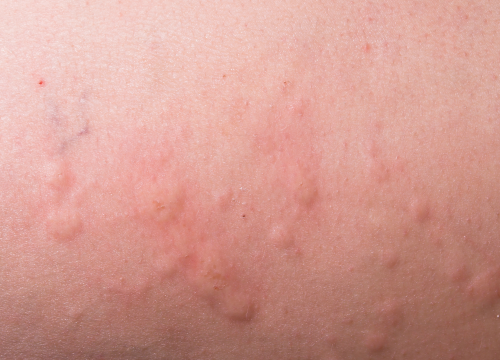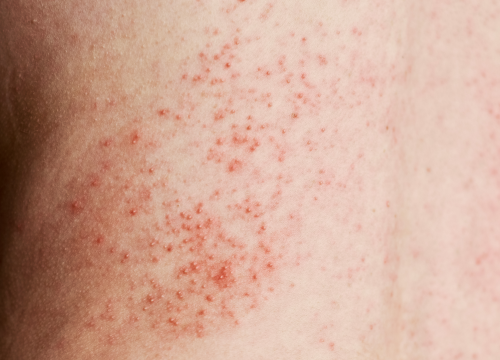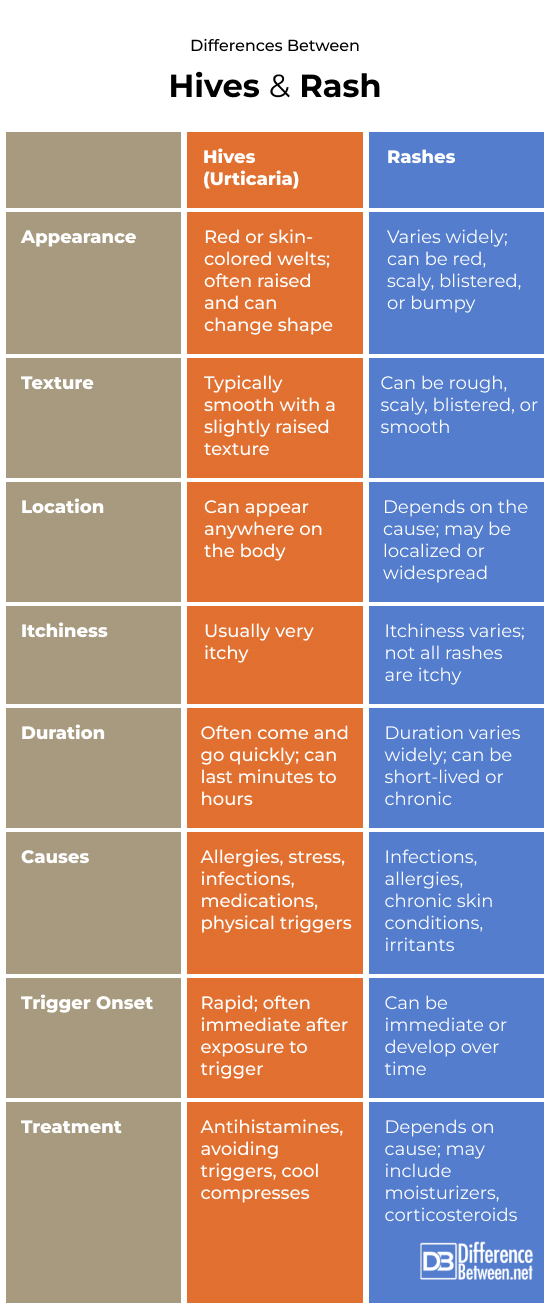Difference Between Hives and Rash
Introduction
Let’s take a closer look at hives and rashes, two skin issues that often get mixed up. Imagine hives as those bothersome, raised welts that pop up when you’re allergic to something, stressed out, or fighting off an infection. They’re the body’s loud reaction to unwelcome guests. Rashes, meanwhile, are like a catch-all term for when your skin gets red, itchy, and irritated, thanks to a whole host of reasons, including allergies, infections, or just ongoing skin troubles. We’re here to walk you through what really causes these skin conditions, how to spot them, and what you can do to feel better. This guide isn’t just for doctors and nurses; it’s for anyone who’s ever felt a mystery itch or found an uninvited red patch on their skin. Let’s discover these skin mysteries together.

What is Hives? (Urticaria)
Definition
Hives, or urticaria, are a distinct skin reaction characterized by the formation of itchy welts. These welts, which can dramatically vary in size, are typically red and raised. They can emerge on any part of the body, sometimes covering large areas.
Causes and Risk Factors
- Allergies: Think of your skin reacting to usual suspects like certain foods (such as nuts, shellfish, and eggs), medications (like antibiotics or aspirin), bug bites, pollen, or even Fluffy the cat.
- Physical Factors: Skin doesn’t like too much pressure, extreme cold or heat, too much sun, or even an intense gym session can cause hives.
- Infections: Regular disorders like colds, UTIs, or throat infections can unexpectedly invite hives.
- Stress: When you’re stressed, your body sometimes responds with these pesky welts.
- Chronic Conditions: Having an autoimmune disorder? It might mean more frequent hive high alerts.
- Chemical Triggers: Some food additives or medicine ingredients don’t sit well with your skin.
- Idiopathic(unknown) Causes: Sometimes, hives just show up unannounced and without a clear why.
- Genetics: Your family tree might hold some clues to your hives mystery.
Symptoms
The hallmark of hives is the rapid onset of red, raised, and often intensely itchy welts. These welts can fluctuate in size, shape, and location, sometimes merging to form larger areas of raised skin. The individual welts usually fade within 24 hours, but new ones may appear, making the condition persist for days or weeks.
Complications
In severe cases, hives can be accompanied by angioedema, a deeper skin swelling often affecting the face, hands, feet, or genitals. This swelling can be uncomfortable and, if it involves the throat or lungs, potentially life-threatening due to breathing difficulties.
Treatment
Treatment primarily focuses on relieving symptoms and preventing triggers. Antihistamines are the first line of treatment, effectively reducing itching and swelling. For persistent or severe cases, doctors may prescribe corticosteroids or other immunomodulatory medications. Identifying and avoiding known triggers is crucial in managing chronic urticaria. In some cases, allergen immunotherapy or biologic therapies may be recommended.

What is Rash?
Definition
Rashes encompass a broad category of skin conditions, characterized by changes in the skin’s appearance or texture. This term is used to describe any noticeable inflammation or discoloration that affects the skin. Unlike hives, which are typically raised and itchy, rashes present a vast array of appearances, textures, and levels of discomfort.
Causes and Risk Factors
- Irritant Encounter: Your skin might rebel against everyday items like soaps or certain plants, leading to rashes.
- Unwelcome Guests: Infections – be they bacterial like impetigo, viral such as chickenpox, or fungal (think athlete’s foot) – can be rash culprits.
- Persistent Skin Foes: Chronic conditions like eczema or psoriasis are infamous for their rash-inducing antics.
- Medicinal Mischief: Sometimes, your body doesn’t agree with certain drugs, resulting in rash outbreaks.
- Internal Battles: Autoimmune diseases like lupus often manifest through skin rashes.
- Heat’s Havoc: Trapped sweat during sultry weather can result in a prickly heat rash.
- Edible Enemies: Allergic reactions to certain foods might show up as rashes.
- Buggy Bites: Insect bites, especially from mosquitoes, often leave itchy, rash-like marks.
- Stress Strikes: High stress can amplify existing skin conditions, leading to rashes.
- Hormonal Highs and Lows: Times of hormonal change, such as pregnancy, can trigger rashes.
- Climatic Challenges: Extreme weather, be it sun, cold, or dryness, can irritate your skin into rashing up.
- Genetic Roulette: If your family is prone to skin issues like eczema, you might find yourself more rash-prone.
Symptoms
Rashes manifest in various forms – red patches, small bumps, blisters, or scales. Some rashes are dry and scaly, while others might be moist or weepy. The affected area may feel itchy, hot, painful, or tender. Unlike hives, which are relatively uniform in appearance, rashes can have numerous distinct patterns and textures.
Complications
Complications from rashes can include secondary infections, especially if the skin is broken from scratching. Chronic rashes can lead to skin thickening or scarring. The impact of visible rashes on psychological wellbeing should also not be underestimated, as they can affect self-esteem and social interactions.
Treatment
Treatment is as varied as the causes. It might involve over-the-counter topical creams for mild rashes or prescription medications for more severe cases. Antihistamines can alleviate itching, while antibiotics or antifungal medications are used for rashes caused by infections. Identifying and avoiding triggers is crucial, especially in cases of allergic rashes. In chronic conditions, ongoing management with specialized therapies might be necessary.
Understanding the diverse nature of rashes is vital for effective diagnosis and treatment. For specific medical advice, it’s always best to consult with a healthcare provider.
Similarities Between Hives and Rash
- Allergic Reactions: Both hives and rashes can be triggered by allergic reactions to substances like foods, medications, or environmental factors.
- Symptoms: Common symptoms for both include itching and redness of the skin, causing discomfort and irritation.
- Treatment with Antihistamines: Antihistamines are often effective in treating both conditions, helping to alleviate itching and reduce redness.
- Skin Inflammation: Both conditions involve some form of skin inflammation, though the specific characteristics and patterns may differ.
- Response to External Stimuli: Hives and rashes can both develop in response to external stimuli, including physical irritants or temperature changes.
Differences Between Hives and Rash – Key Differences
- Hives are specifically welts that appear and disappear, while rashes can include a variety of skin lesions.
- Hives are often a result of an allergic reaction, whereas rashes have a broader range of causes.
- Hives typically resolve on their own or with antihistamines, but some rashes may require specific treatments like antibiotics.
- Hives are usually not contagious, but rashes can be, especially if caused by an infectious agent.
- The texture of hives is generally smooth, while rashes can be scaly, bumpy, or have blisters.

Summary
While hives and rashes share some similarities, such as their itchy nature and potential allergic causes, they are distinct conditions. Understanding these differences is crucial for effective treatment and management.
FAQs
Are hives and rashes the same thing?
No, hives and rashes are not the same. Hives (urticaria) are specific types of red, itchy welts, while rashes cover a broader range of skin reactions with various causes and appearances.
What does a hive rash look like?
Hives appear as raised, red, and itchy welts on the skin. They can vary in size and shape and may blend together to form larger areas.
Do hives spread by scratching?
Scratching doesn’t cause hives to spread, but it can irritate the skin and potentially lead to infection.
Are hives hard or soft?
Hives are generally soft to the touch and can feel slightly raised and swollen.
Should I take Benadryl for hives?
Benadryl, an antihistamine, can be effective for treating hives, but it’s best to consult a healthcare professional for advice.
What triggers hives?
Hives can be triggered by allergic reactions, stress, certain medications, infections, and physical factors like pressure or temperature.
Why am I suddenly getting random hives?
Sudden hives can result from allergies, stress, infections, or other triggers. If the cause is unclear, consulting a healthcare professional is advisable.
What is the best treatment for hives?
Antihistamines are commonly used to treat hives. Severe cases may require corticosteroids or other prescription medications.
How do you get rid of a hive fast?
Applying cool compresses and taking antihistamines can help alleviate symptoms quickly. Avoiding triggers is also important.
Why do hives get worse at night?
Hives may worsen at night due to changes in body temperature or the release of certain body chemicals during sleep.
How long does hives last?
Hives typically fade within 24 hours, but new welts may form. The condition can last for days to weeks, depending on the cause.
What is the best anti-itch cream for hives?
Over-the-counter hydrocortisone cream can help relieve itching. For more severe cases, a prescription-strength cream may be necessary.
- Difference Between Psychopath and Sociopath - April 2, 2024
- Difference Between IQ and EQ - April 2, 2024
- Difference Between Good Carbs and Bad Carbs - April 2, 2024
Search DifferenceBetween.net :
 Email This Post
: If you like this article or our site. Please spread the word. Share it with your friends/family.
Email This Post
: If you like this article or our site. Please spread the word. Share it with your friends/family.
Leave a Response
References :
[0](i) Hide, M., Takahagi, S., & Hiragun, T. (2019). Urticaria and Angioedema. In S. Kang, M. Amagai, A. L. Bruckner, A. H. Enk, D. J. Margolis, A. J. McMichael, & J. S. Orringer (Eds.), Fitzpatrick's Dermatology (9th ed., pp. 684-710). McGraw-Hill Education.
[1](ii) Hide, M., Takahagi, S., & Hiragun, T. (2019). Urticaria and Angioedema. In S. Kang, M. Amagai, A. L. Bruckner, A. H. Enk, D. J. Margolis, A. J. McMichael, & J. S. Orringer (Eds.), Fitzpatrick's Dermatology (9th ed., pp. 684-710). McGraw-Hill Education.
[2](iii) Hide, M., Takahagi, S., & Hiragun, T. (2019). Urticaria and Angioedema. In S. Kang, M. Amagai, A. L. Bruckner, A. H. Enk, D. J. Margolis, A. J. McMichael, & J. S. Orringer (Eds.), Fitzpatrick's Dermatology (9th ed., pp. 684-710). McGraw-Hill Education.
[3](iv) James, W. D., Elston, D. M., Treat, J. R., & Rosenbach, M. A. (2016). Andrews’ Diseases of the Skin: Clinical Dermatology (12th ed., pp. 146-150). Elsevier, Inc.
[4](v) Happel, C. S. (2017). Rash diagnostics: An update on the diagnosis of allergic rashes. Current Opinion in Pediatrics, 29(3), 371–378. https://doi.org/10.1097/MOP.0000000000000489
[5](vi) Happel, C. S. (2017). Rash diagnostics: An update on the diagnosis of allergic rashes. Current Opinion in Pediatrics, 29(3), 371–378. https://doi.org/10.1097/MOP.0000000000000489
[6](vii) Happel, C. S. (2017). Rash diagnostics: An update on the diagnosis of allergic rashes. Current Opinion in Pediatrics, 29(3), 371–378. https://doi.org/10.1097/MOP.0000000000000489
[7]Hide, M., Takahagi, S., & Hiragun, T. (2019). Urticaria and Angioedema. In S. Kang, M. Amagai, A. L. Bruckner, A. H. Enk, D. J. Margolis, A. J. McMichael, & J. S. Orringer (Eds.), Fitzpatrick's Dermatology (9th ed., pp. 684-710). McGraw-Hill Education.
[8]Griffiths, C. E. M., Barker, J., Bleiker, T. O., Chalmers, R., & Creamer, D. (2016). Rook’s Textbook of Dermatology, 4 volume set. John Wiley & Sons.
[9]James, W. D., Elston, D. M., Treat, J. R., & Rosenbach, M. A. (2016). Andrews’ Diseases of the Skin: Clinical Dermatology (12th ed., pp. 146-150). Elsevier, Inc.
[10]Happel, C. S. (2017). Rash diagnostics: An update on the diagnosis of allergic rashes. Current Opinion in Pediatrics, 29(3), 371–378. https://doi.org/10.1097/MOP.0000000000000489
[11]Image credit: https://www.canva.com/photos/MAEGjXZvKWo-rashes-on-skin/
[12]Image credit: https://www.canva.com/photos/MAEyYGPMUOI-hives/

